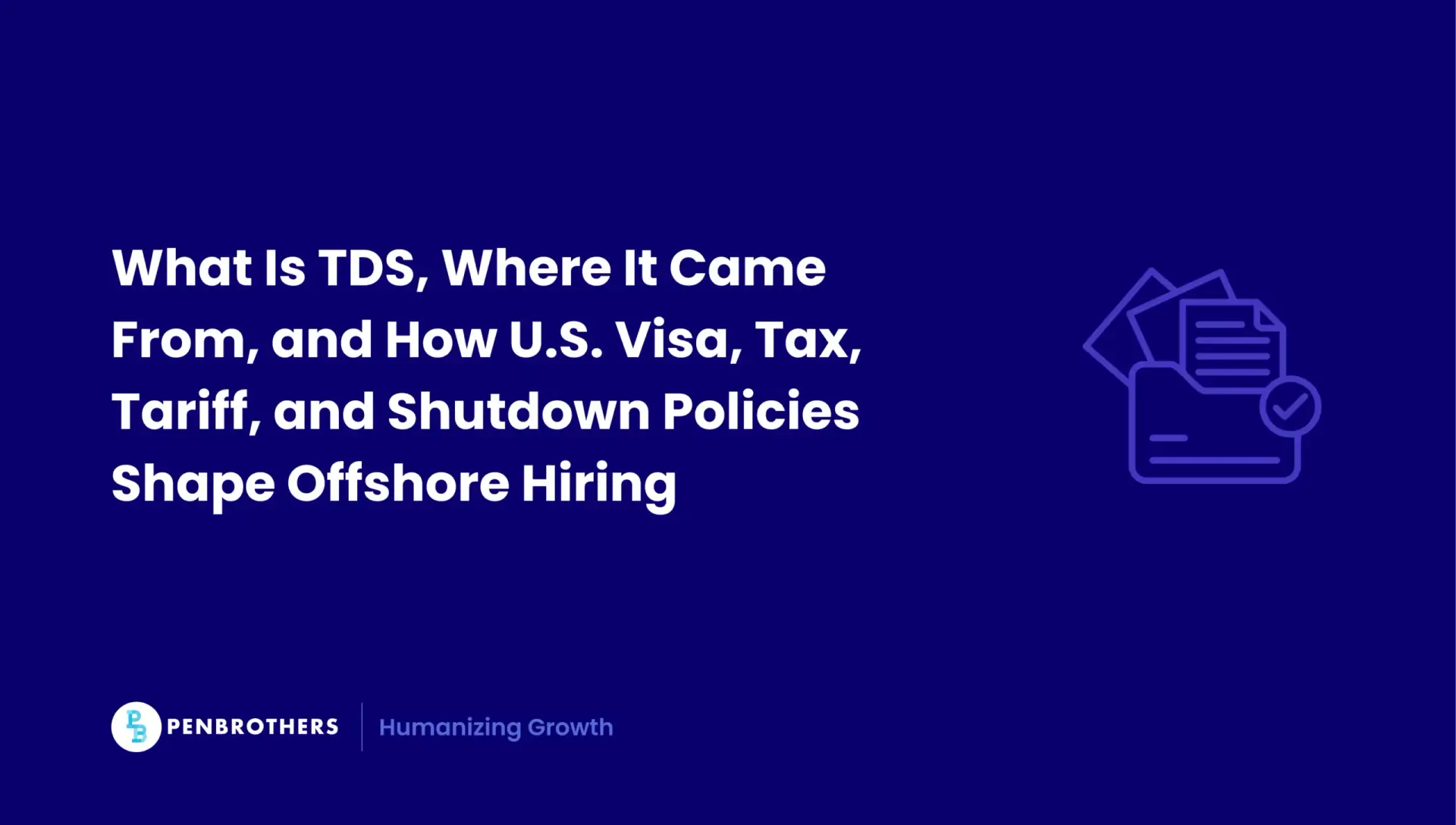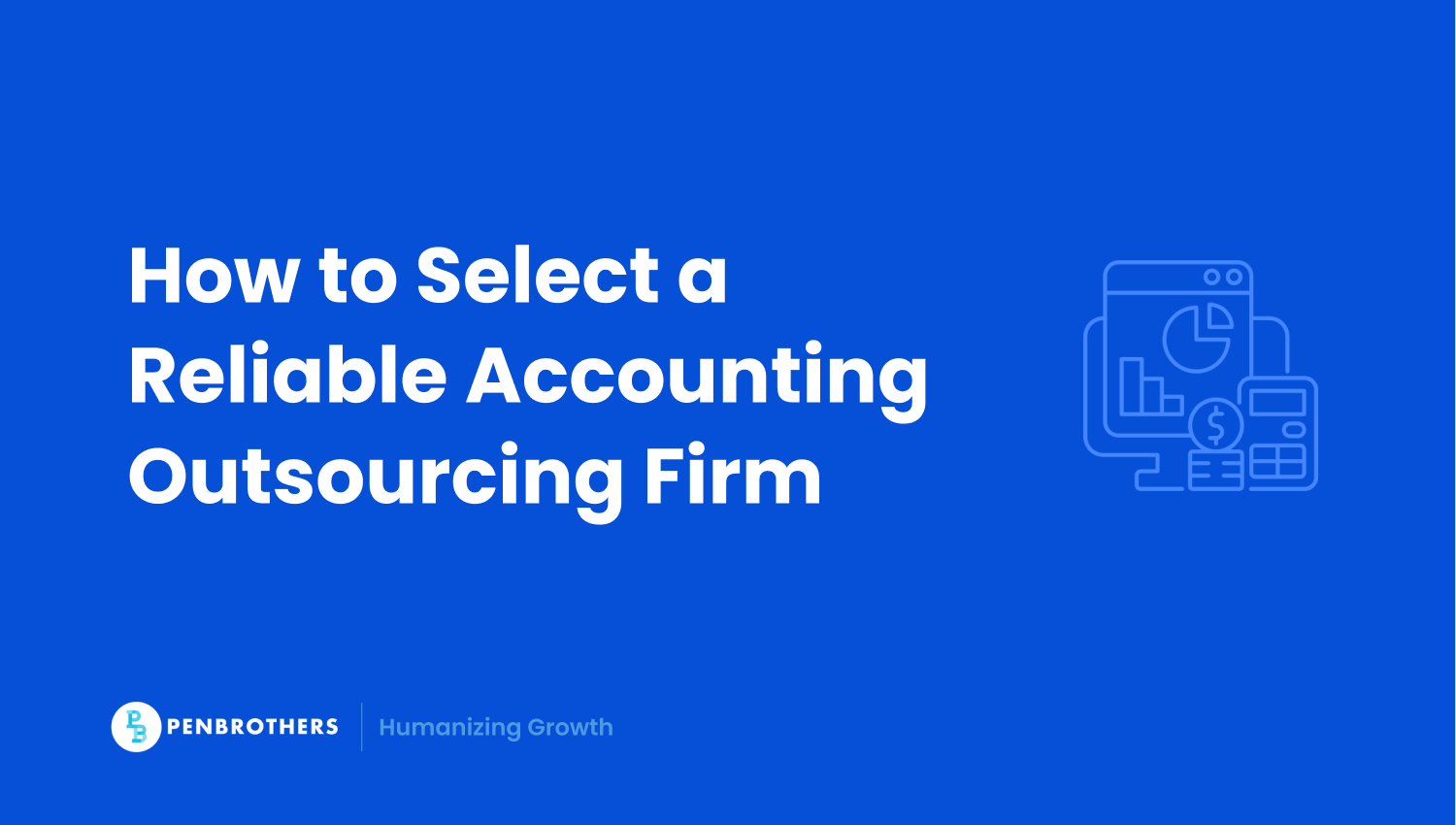What's Inside?
What Is TDS? A Neutral Guide to the Term and the Real Policy Effects on Outsourcing

Key Takeaways
- Focus on Actual Policies, Not Political Rhetoric: The term “TDS” (Trump Derangement Syndrome) is political terminology, not a business metric. For executives, the focus should not be on the validity of the label but on the concrete, verifiable policies enacted during that period, as these are what directly impact business operations and strategy.
- Key Policies Created Uncertainty and Increased Costs for U.S.-Based Hiring: Several key policy actions—such as the “Buy American, Hire American” executive order, changes to the H-1B visa selection process, and disruptions to federal services like E-Verify during government shutdowns—made hiring skilled foreign workers for U.S.-based roles more expensive, uncertain, and time-consuming.
- The 2017 Tax Law Reshaped the Economics of Global Operations: The Tax Cuts and Jobs Act (TCJA) of 2017 introduced complex international tax provisions like GILTI, FDII, and BEAT. These rules changed the financial calculations for U.S. companies with cross-border operations, particularly those with their own “captive” offshore centers.
- These Policies Increased the Strategic Importance of Offshore and Nearshore Teams: The combined effect of these policies was an increase in the strategic value of a geographically diversified workforce. The increased friction and cost of bringing foreign talent into the U.S. made building offshore and nearshore teams a more attractive option for ensuring business continuity, accessing talent, and managing risk.
What Does “TDS” Mean
The acronym TDS carries multiple meanings depending on context. In water quality analysis, it measures Total Dissolved Solids. In Indian tax administration, it means Tax Deducted at Source. Medical contexts use it for testosterone deficiency syndrome. But in American political discourse since 2015, TDS almost exclusively means Trump Derangement Syndrome.
This requires disambiguation. The term is not a clinical diagnosis. It does not appear in the American Psychiatric Association’s Diagnostic and Statistical Manual of Mental Disorders. It is political terminology, used by supporters of Donald Trump to characterize what they perceive as irrational or disproportionate criticism of the former president. Critics of the term argue it functions to dismiss substantive policy disagreement. Some have appropriated it to describe what they view as uncritical support for Trump among his base.
The etymology traces to “Bush Derangement Syndrome,” coined by psychiatrist and columnist Charles Krauthammer in 2003 to describe what he characterized as paranoid opposition to George W. Bush. The Trump variant first appeared in an August 2015 op-ed by Esther Goldberg in The American Spectator, initially applied to establishment Republicans dismissive of Trump’s candidacy.
The term’s usage reveals more about the speaker’s political position than about any measurable phenomenon. What matters for business leaders making staffing decisions is not the rhetorical frame but the actual policy record.
Why TDS Shows Up in Hiring and Offshoring Debates
Political rhetoric moves quickly. Hiring decisions should not.
The companies making global staffing decisions base those decisions on immigration rules, corporate tax provisions, trade measures, government operations during appropriations lapses, and monetary policy signals from the Federal Reserve. These are the mechanics that matter. The documentary record shows what changed, when it changed, and what it means for organizations that need to staff teams, meet deadlines, and control costs.
Whether criticism of Trump is rational or excessive is a question for political scientists. For business leaders, the question is different. How do H-1B selection mechanics work now. What does GILTI do to cross-border tax exposure. Are Section 301 tariffs still in force. What happens to E-Verify during a shutdown. These questions have answers in federal statutes, executive orders, agency rulemakings, tariff schedules, and appropriations documents.
U.S. Immigration Policy Touchpoints Relevant to Offshore Staffing
Executive Order Framing “Buy American, Hire American”
On April 18, 2017, the administration issued what became the guiding document for subsequent immigration actions. Executive Order 13788, titled “Buy American and Hire American,” directed federal agencies to propose rules and guidance designed to protect U.S. workers in the administration of immigration programs. The archived text from the Trump White House runs short. The language is direct. The order does not ban anything outright, but it establishes the frame. Everything that followed traces back to this document.
H-1B Selection and Process Changes
Following the executive order, the Department of Homeland Security and U.S. Citizenship and Immigration Services advanced rulemaking to change how H-1B cap selection operates and how filings get processed. The mechanics live in the federal docket system. You can read the regulatory history in USCIS docket USCIS-2020-0019 on Regulations.gov, or review the proposed rule PDF for the technical details.
In 2025, new proclamations restricted the entry of certain nonimmigrant workers and imposed additional conditions. The presidential proclamation restricting entry and its accompanying fact sheet outline the current requirements.
The practical effect: selection mechanics changed, filing windows shifted, entry restrictions created planning risk for onshore roles. Some firms responded by maintaining dual tracks. They petition for critical U.S. roles when the economics and timing work. They expand offshore teams for speed, continuity, and cost control when those factors do not align.
The visa system did not collapse. It became more expensive, more uncertain, more time-consuming. That creates a different set of strategic problems, which produces different operational responses.
Corporate Tax Rules That Influence Offshoring Decisions
Clarifying the HIRE Act Misconception
There is recurring confusion about an “outsourcing tax” connected to something called the HIRE Act. This requires correction.
The Hiring Incentives to Restore Employment Act was enacted in 2010, during the Obama administration, to address unemployment following the 2008 financial crisis. It predates the Trump administration entirely. When evaluating tax effects on globalization strategies during and after 2017, the HIRE Act is not relevant. The law that matters is the Tax Cuts and Jobs Act.
The Tax Cuts and Jobs Act of 2017
The Tax Cuts and Jobs Act, signed December 22, 2017, restructured corporate and international tax. The full legislative text is available on Congress.gov, and the enrolled bill PDF runs to several hundred pages. The IRS published a comparison for large businesses and international taxpayers that summarizes the international provisions.
Four provisions matter most for companies with cross-border operations.
GILTI—Global Intangible Low-Taxed Income—taxes certain foreign profits of controlled foreign corporations that exceed a 10 percent return on tangible assets held abroad. The effective tax rate is 10.5 percent, rising to 13.125% after 2025. The provision affects how profits in low-tax jurisdictions are treated.
FDII—Foreign-Derived Intangible Income—provides a deduction that results in a lower effective tax rate on income derived from exporting goods and services linked to intellectual property held in the United States. The deduction creates an incentive to locate valuable IP and related activities domestically rather than offshore.
BEAT—Base Erosion and Anti-Abuse Tax—imposes a minimum tax on large corporations that make significant deductible payments to foreign related parties. If you operate a captive offshore center and make substantial service payments to your own foreign subsidiary, BEAT may apply.
The transition tax was a one-time levy on previously untaxed foreign earnings, implemented during the shift toward a participation-exemption system. It addressed the old regime. It does not affect ongoing operations.
What These Provisions Mean for Operating Models
Companies running captive centers—their own offshore entities—must model TCJA’s international rules carefully. Intercompany flows, substance requirements, risk allocation. The analysis is technical. The stakes are real.
Companies using third-party outsourcing often face a simpler tax profile. Payments to independent vendors are service expenses. Transfer pricing and procurement governance still matter, but you are not navigating GILTI calculations or BEAT exposure in the same way.
The right model depends on your structure, your margins, your risk tolerance. Evaluate cross-border tax exposure alongside hiring speed, wage inflation, skills availability, operational risk. There is no universal answer. There is your answer, determined by your constraints and your priorities.
Tariffs and Trade Actions That Affected Cost Structures
Section 232 Measures on Steel and Aluminum
National-security tariffs on steel and aluminum were imposed and later adjusted through presidential proclamations under Section 232 authority. The Federal Register contains the authoritative texts. The 2018 proclamation adjusting steel imports established the initial tariff structure. The 2025 aluminum update and the combined steel and aluminum adjustments show how the measures evolved.
Section 301 Actions on China
The administration initiated Section 301 actions addressing China’s technology transfer and intellectual property practices. This produced staged tariff tranches. The March 22, 2018 fact sheet from USTR outlines the rationale. The investigation page with timeline and report links documents the progression.
Supply Chain and Location Strategy Effects
Tariffs increase input costs. They also increase uncertainty.
U.S. importers responded by diversifying supply chains across multiple countries and by rebalancing which activities stay onshore versus offshore. For services-heavy functions—software development, customer support, back-office operations—labor location is driven more by wages, skills supply, and immigration predictability than by goods tariffs. But the two interact through total landed cost. When physical supply chains become more expensive and less predictable, companies look for flexibility elsewhere. Labor costs are one of the few variables that move quickly.
Government Shutdowns, Agency Funding, and Hiring Friction
What Shuts Down and What Continues
During appropriations lapses, fee-funded operations can continue while activities dependent on annual appropriations must pause. U.S. immigration processing is a patchwork. Some offices keep working. Others go dark.
The Office of Personnel Management publishes furlough guidance and contingency practices. The HUD and NFFE collective bargaining document and the Army CBA example show how agencies categorize essential and non-essential functions.
Immigration Bottlenecks During Shutdowns
In the 35-day lapse that began December 22, 2018, E-Verify was suspended. Department of Labor processes, including Labor Condition Application certifications, experienced delays or stopped entirely. LCAs are required before filing H-1B petitions. No LCA means no petition. No petition means no visa.
The system did not fail. It stopped. When appropriations lapse, expect friction in any process that relies on appropriated staff or systems.
Planning Guidance for U.S. Hiring Leaders
Build buffer time for filings and onboarding during the U.S. fiscal year crossover. Maintain contingency plans for delayed verifications or certifications. Keep critical roles on parallel paths with offshore teams when timelines are sensitive.
Interest Rates and the Cost of Capital Context
What the Fed’s Statements and Calendars Tell Us
The Federal Open Market Committee determines monetary policy. The committee publishes meeting calendars, policy statements, and minutes that establish the policy rate path. This flows into financing costs and labor market conditions. The overview of the FOMC’s role provides institutional background.
Why Rates Matter for Offshore Strategy
Higher rates raise the cost of capital. This heightens scrutiny on payroll growth. It can accelerate rebalancing toward lower-cost delivery centers.
Lower rates ease some constraints. But wage inflation and skills scarcity can still push teams to diversify globally.
The Fed does not control your hiring plan. The Fed controls the cost of borrowing, which controls your room to experiment, your spending capacity for automation, your flexibility when payroll grows faster than revenue. Interest rates are background music. You do not always notice them. Then they change.
2017 to Present, a Policy Timeline for Offshore Decision-Makers
April 18, 2017: The administration issues Executive Order 13788, Buy American and Hire American, directing agencies to propose rules protecting U.S. workers in immigration administration.
December 22, 2017: The Tax Cuts and Jobs Act becomes law as Public Law 115-97. Read the H.R.1 page on Congress.gov or download the enrolled bill PDF.
March 2018 onward: Section 232 proclamations adjust imports of steel and aluminum through tariffs. See the steel Federal Register notice from 2018 and the 2025 aluminum update.
March through June 2018: Section 301 investigation and actions address China’s intellectual property and technology transfer practices. Review the March 2018 fact sheet and the investigation page.
2019 and later: Shutdown guidance from OPM and agencies shows which operations pause and which continue under fee funding. The OPM furlough example documents the process.
2020 through 2021: USCIS advances rulemaking on H-1B registration and selection. Follow the progression in docket USCIS-2020-0019.
2025: New proclamations restrict entry of certain nonimmigrant workers and adjust Section 232 tariffs.
Related articles:
- Trump on IT Outsourcing: HIRE Act Facts, Risks, and Next Steps
- Outsourcing to India and the HIRE Act: What U.S. Companies Should Do Now
- Outsourcing Tax: What Is Official, What Is Proposed, What Is Noise
- Fed Rate Cuts and Outsourcing in 2025: Executive Guide
- Trump’s $100K H-1B Visa Fee Explained: Policy and Reactions
- Federal Minimum Wage 2025: What U.S. Employers Need to Know
What This Means for U.S. Executives Building Offshore Teams
Constraints and Costs to Watch
Visa selection and entry restrictions can create timing risk. You file. You wait. You hope. Sometimes it works. Sometimes it doesn’t.
International tax exposure under GILTI, FDII, and BEAT needs modeling for captive structures. This isn’t optional. It’s math.
Tariffs alter input costs and planning assumptions for goods-related work. If you’re importing physical products, you’ve already adjusted. If you haven’t, you’re behind.
Shutdowns can disrupt verifications and certifications tied to appropriated functions. E-Verify goes offline. LCAs stop processing. Your hiring timeline extends by weeks or months for reasons unrelated to the quality of your candidates.
Offsetting Factors and Practical Options
Third-party outsourcing can reduce execution risk when onshore hiring is delayed. You’re not navigating visa lotteries or GILTI calculations. You’re paying a vendor for delivered work.
A balanced delivery model spreads work across U.S., nearshore, and offshore teams to protect timelines and cost baselines. No single point of failure. No single jurisdiction risk.
When a captive center is strategic—when you need full control, deep integration, proprietary processes—invest early in tax, compliance, and process readiness. Captive models can work. They just require more planning, more legal spend, and more patience.
Action Checklist
- Validate H-1B and other visa timelines against current rules and any entry proclamations.
- Model TCJA exposures, especially GILTI, FDII, and BEAT, with cross-border flows.
- Run tariff sensitivity for critical inputs affected by Section 232 and Section 301 actions.
- Set contingencies for E-Verify, LCAs, and related steps during potential shutdowns.
- Track FOMC outcomes to align hiring cadence with cost of capital and demand signals.
What Penbrothers Does
We help companies build offshore teams in the Philippines. Not the way BPOs do it. We stay involved. We provide what we call the Hypercare Framework, which means onboarding support, ongoing alignment, troubleshooting when things go sideways. The work is to make offshore teams function like they are not offshore at all.
You just read several thousand words about visa uncertainty, tax modeling, tariff exposure, shutdown risk. Those are real constraints. They affect your hiring timeline. They affect your costs. They affect whether you can get the people you need when you need them.
Offshore is not a perfect solution. Nothing is. But it is a knowable solution, which matters when everything else is moving. If you are building teams and need options that do not depend on lottery systems or shifting proclamations, we can help. Start here.
Frequently Asked Questions
In modern American political discourse, “TDS” stands for Trump Derangement Syndrome. It is a political term, not a clinical diagnosis, used by supporters of Donald Trump to describe what they see as irrational or excessive criticism of him. The term is a pejorative and its use typically indicates the speaker’s political viewpoint.
While the term itself is not a business factor, it often appears in debates surrounding the policies of the administration it is associated with. For business leaders, it is important to separate this political rhetoric from the actual, documented policies concerning immigration, taxes, and trade that were enacted, as those policies have a direct and measurable impact on global hiring and outsourcing strategies.
The primary changes were driven by the “Buy American, Hire American” executive order. This led to administrative shifts in the H-1B cap selection and filing process and later, new proclamations that restricted the entry of certain workers and imposed additional fees. The overall effect was to make the process of bringing skilled foreign workers into the U.S. on H-1B visas more expensive, uncertain, and time-consuming.
The TCJA introduced several new international tax provisions, most notably GILTI, FDII, and BEAT. These rules were designed to change the tax incentives for where U.S. companies hold their intellectual property and earn their foreign profits. This made the financial and tax calculations for companies with cross-border operations, especially those with their own “captive” offshore subsidiaries, significantly more complex.
The overall effect was an increase in the strategic importance of a geographically diversified workforce. The combination of increased costs, risks, and uncertainty for hiring onshore foreign talent (due to H-1B issues and shutdown delays) made building offshore and nearshore teams a more critical part of a company’s risk management and business continuity strategy, not just a cost-cutting one.




